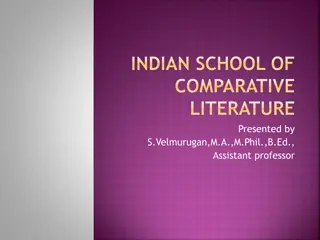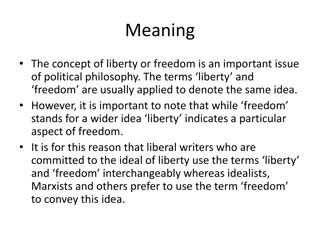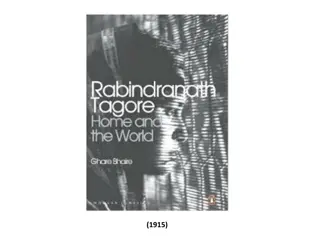Exploring 'Kanthapura': A Journey into Indian Freedom Struggle through Literature
"Indian author Raja Rao's novel 'Kanthapura' portrays the impact of Gandhi's freedom movement in a small village. The story follows Moorthy, a passionate follower of Gandhi, as he spreads the message of nonviolent resistance. This groundbreaking work blends traditional folk tales with modern literary elements, showcasing the struggle for independence in colonial India."
Download Presentation

Please find below an Image/Link to download the presentation.
The content on the website is provided AS IS for your information and personal use only. It may not be sold, licensed, or shared on other websites without obtaining consent from the author. Download presentation by click this link. If you encounter any issues during the download, it is possible that the publisher has removed the file from their server.
E N D
Presentation Transcript
I.B. (P.G.) COLLEGE,PANIPAT CLASS : M.A. (ENGLISH) PREVIOUS YEAR PAPER: LITERATURE IN ENGLISH UNIT : KANTHAPURA TOPIC : 1. ABOUT THE NOVEL 2.SUMMARY OF THE NOVEL 3.CHARACTER LIST
SINCERE THANKS TO DR. AJAY KUMAR GARG PRINCIPAL I.B. P.G. COLLEGE,PANIPAT DR. MADHU SHARMA HEAD DEPARTMENT OF ENGLISH, I.B. COLLEGE
PRESENTED BY DR. VANDANA ROHAL ASSISTANT PROFESSOR I.B. COLLEGE
BACKGROUND OF KANTHAPURA Indian author Raja Rao's debut novel Kanthapura published in 1938 is perhaps the novel that he is best known for. The title comes from the setting of the story, Kanthapura in Southern India, and the book follows the impact of Mahatma Gandhi and his movement to liberate India from British colonial rule on this small, common village. It is told from the perspective of an old woman in the village, who notes all of the comings and goings in Kanthapura, bringing along years of expertise and life experience with her. The novel received widespread appreciation and is now considered to be among the leading, if not the first, significant Indian novels to be written in English. It is a combination between a traditional folk tale and a modern contemporary novel as it combines the drama and legends of a typical Indian folk-epic with a poeticism of a modernist work of literature and as such, is regarded as a groundbreaking novel for both English and Indian literature alike. Raja Rao was born in 1908 and lived an incredibly long life of 97 years. In that time he became an accomplished writer for his books exploring the philosophical features and characteristics of reality and its impact on the everyday lives of the population. He won numerous awards for his works across multiple genres and is viewed as a founding father of Indian English literature.
SUMMARY OF THE NOVEL Kanthapura is the most prolific and idealistic novel written by Raja Rao. Rao wrote this novel while in France, which is typically miles away from his homeland India. The prime purpose of this novel is to give an account of Gandhi s fight for freedom starting the year 1919 to 1930. The novel as well gives an account of Gandhi s influence on the Indian freedom movement. The scene of the novel s action is Kanthapura, which is a village located in the South of India. The main character in this novel is Moorthy who is an educated youth from the metropolis. Moorthy is a top devotee of Gandhi s social defiance pressure group who is coming to this remote village to spread the gospel of Mahatma, which primarily focuses on freedom. He moves from one house to the other to preach the significance of Gandhi s struggle for freedom. He convinces people to be part of the defiance freedom movement to get out of the colonial master's captivity. A few days later, Moorthy spearheads the formation of a Congress Committee in the village. Gandhi s people from the city bring publicity materials, which are given out to people freely to ensure that they are well informed about the objectives of the freedom movement. Congress forms a corps unit that is tasked with the responsibility of training followers of the movement to remain non-violent at all times including when they face oppression from the government forces. To assist in the organization of the freedom movement in the village, Ratna a youthful woman who is enlightened and brilliant on the issues of freedom struggle comes in to assist Moorthy.
In response to the formation of the Gandhi freedom movement in Kanthapura village, the colonial administration comes up with prompt strategies to counter Gandhi and contain his moves. The government posts Khan (police officer) to Kanthapura village to contain the situation. Bhatta actively assists the police officer by enlisting the most influential people from the city who are misleading the ignorant people of the Kanthapura village. Among the people enlisted are powerful religious leaders and Moorthy. Bhatta promises to teach any person misleading the village people a hard lesson. Moorthy goes ahead to rally the village to protest the mistreatment from their plantation masters. They demonstrate and rally around the toddy agricultural estate. The colonial police respond by wounding many villagers while arresting others who are late jailed. This move leads to the rigorous protests outside the coffee estates as villagers demand justice. This time, the colonial government responds more ruthlessly than the first time. The police do not spare the old, children and women during the picketing. The villagers working in the Skeffington Coffee Farm get angry when they see their fellow villagers being tormented by the government. They decide to join the protest and the situation becomes worse for the government. As a result, Moorthy is detained and decreed to a long-term jail term. Ratna remains and takes charge of the Congress to continue with Gandhi s struggle for freedom. She organizes and trains many young women to be front-runners in the fight for freedom. The freedom fighters under Gandhi s movement launched a campaign influencing their followers not to pay taxes and land revenues to the red man s government. The freedom fighters educate their followers on the significance of remaining non-violent despite the government s move to destroy their farms and properties. The government responds by brutally shooting the protesters and wounding thousands. The merciless shootings make the protesters start responding violently and the situation becomes worse. All protesters are shouting praises for Mahatma Gandhi while condemning the acts of the red man s government. The government forces overpower the protesters who are later forced to flee the village.Despite being defeated by the government, the villagers have demonstrated their bravery. They flee the village to unknown places where they find shelter. The villagers' actions through the freedom movement shake the British government which is later forced to withdraw their rule from India in the year 1947. This paves the way for the Kanthapura people under the leadership of Gandhi to walk towards self-rule.
CHARACTER LIST Moorthy Moorthy is a young Brahmin (high social caste in India) who has returned to his village Kanthapura. He is heavily inspired by the Mahatma Gandhi's nationalist movement to liberate India. He is showered with love and respect by the people of Kanthapura, who decide to follow him unflinchingly. In the novel, he is referred to as the 'small mountain', while Mahatma Gandhi is the ' big mountain'. He manages to establish the Congress Party in adherence to Gandhian values in Kanthapura. Bhatta Bhatta is the chief priest of Kanthapura. He exploits the villagers and has nothing to do with the Gandhian philosophy. He goes on to oppose Moorthy in establishing the Congress Party. Bhatta is an indirect agent of the British government. He can be perceived as one of the antagonists of the novel. Patel Range Gowda Officially, Patel Range Gowda is the Primary Executive Officer of Kanthapura village. However, he acts as the mayor of the entire village. He has a strong and formidable presence, and no decision can reach its conclusion without Range Gowda's approval. He is often referred to as the 'tiger' of the village. He uses his social authority in order to assist Moorthy.
Rangamma Rangamma is a widely respected woman who can read and write. She is a childless widow, but she does not let it bring her down. She is respected because of her strong resolution and high aspirations. She rejects Bhatta's religious dictatorship in favour of Gandhian Moorthy. She educates and leads the women of Kanthapura to form a non-violent resistance group called 'Sevis'. Bade Khan Bade Khan is a Muslim policeman who has recently arrived in Kanthapura. He finds lodging in Skeffington Coffee Estate. He is an agent of the British government and is hostile towards all forms of protests. Bade Khan goes on to viciously beat Moorthy when he tries to meet the coffee estate workers. Kamalamma Kamalamma is the sister of Rangamma. She stands in stark contrast to the values exhibited by Rangamma. She rejects her sister's conversion to the Gandhian lifestyle. The only concern on her mind is to somehow remarry her widowed daughter Ratna. Ratna Ratna is the fifteen year old daughter of Kamalamma. However, she has more in common with her Aunt Rangamma. She, too, is inspired by the Gandhian philosophy. Despite being a widow, she does not care for traditional social propriety. She leads the Sevis after Rangamma's imprisonment.
THEMES IN THE NOVEL The Evils of the Colonial Rule in India In the novel, Rao explains vividly on the evils of the Red Man s administration in India. The exploitation of the Indians by the colonialists led to the formation of Gandhi s freedom movement. Most of the action and sufferings of the people of India is demonstrated in the village of Kanthapura, which is located in the southern parts of India. Moorthy, a strong supporter of Gandhi moves to the remote village to mobilize people on the evils of the colonialists in their country. Moorthy forms a Congress, which later forms a large following of villagers against the Red Man s administration. When villagers demonstrate against the oppression of their masters in the coffee plantations, the government sends its police officers to terrorize the protesters. Many people are killed and wounded in the protests. Moorthy is arrested alongside other freedom fighters for going against the will of the government. Throughout the novel, the reader can understand the hardships Indians had to go through before gaining the independence. There are torture, killings, and unlawful arrests. However, at last, the villagers and Indians at large emerge victorious when they achieve the self-rule.
The Place of Young Women in Leadership Raja Rao s novel focuses on the capability of women in leadership. To be more specific, Rao talks of the young woman by the name Ratna who is well educated and versed with issues of organizing freedom movements. Ratna is the main character who assists Moorthy in the fight for independence. She is also a strong devotee of Gandhi s philosophies. She believes that people can fight for their freedom without necessarily engaging in violence. When Moorthy is arrested and imprisoned for an unknown period, Ratna takes the leadership of the Congress. She takes the lead role of training other young women to be leaders of the freedom movement. Therefore, the novel vividly describes the place of women in the fight against the Red Man s government oppression in India.
Education as a Powerful Tool to Fight Colonialism Largely, the colonialists took advantage of the ignorance of the Indians to rule them. The people at the Kanthapura village are portrayed as ignorant. However, when Moorthy moves into the village, things take a drastic turn. Moorthy is an educated youth from the Metropolis who understands how the evils of the Red Man s administration can be fought. He educates the villagers on the evils of the colonialists moving from one house to the other. He later organizes a Congress in the village in which publicity materials from the city are circulated free to the people to educate them on the objectives of the freedom movement and the importance of self-rule. Moorthy is assisted by a young educated woman by the name Trina to spearhead the objectives of the movement. Through education, the villagers become aware of the evils of the colonialists and they join hands to fight for independence. It is not an easy struggle but lastly, they manage to withdraw the British rule and walk to self-determination.























